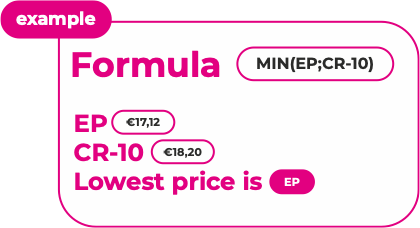What does the MIN/MAX formula do in the repricer?
With the min and max formula in the repricer, you can immediately use the lowest or highest value out of 2 values.
For example, you can use the MIN formula to enter 2 values (usually through placeholders) and have the repricer immediately select the lowest of the 2 values. For the max formula, the exact opposite applies, then the repricer immediately selects the maximum value from the 2.
For example, if you have your price adjusted with the formula MIN(EP;500), then the repricer first looks at which of the 2 values is the lowest and uses that price. Does your competitor (for which the placeholder EP acts) have a price of 7.99 (799 cents)? Then that value is higher than the 500 you entered yourself. The repricer will then adopt the 500 value. Does your competitor have a price of 3.99 (399 euro cents)? Then that is obviously the lowest value, which the repricer will use.
This formula is usually used when you want to adjust your price directly to the competitor's price, and then apply your own price again. A good example is the use of EP and CR:

In this formula, the repricer checks which of the two values is the lowest. Which is the external product price (EP). The repricer will adopt the external product price of €17,12. At this point, your last reprice price (CR) will also be €17,12. When the calculation happens again, the repricer will again look at which of the two prices is the lowest. Is this the EP (€17,12)? Or CR-10 (€17,12 - 0,10 = €17,02)? Obviously, the second. So the repricer will then take your last reprice price, minus 10 Eurocents.
To know more about using formulas, read this article.
![]() Good to know: if you use a placeholder in your formulas, it is also important that this placeholder contains a price for all products. Otherwise, a product will be skipped when it has an empty value in a placeholder.
Good to know: if you use a placeholder in your formulas, it is also important that this placeholder contains a price for all products. Otherwise, a product will be skipped when it has an empty value in a placeholder.
For example: if you use PI in your formulas, which represents the purchase price, then you should also have a purchase price in your data for all your products. Otherwise, the product will be skipped.